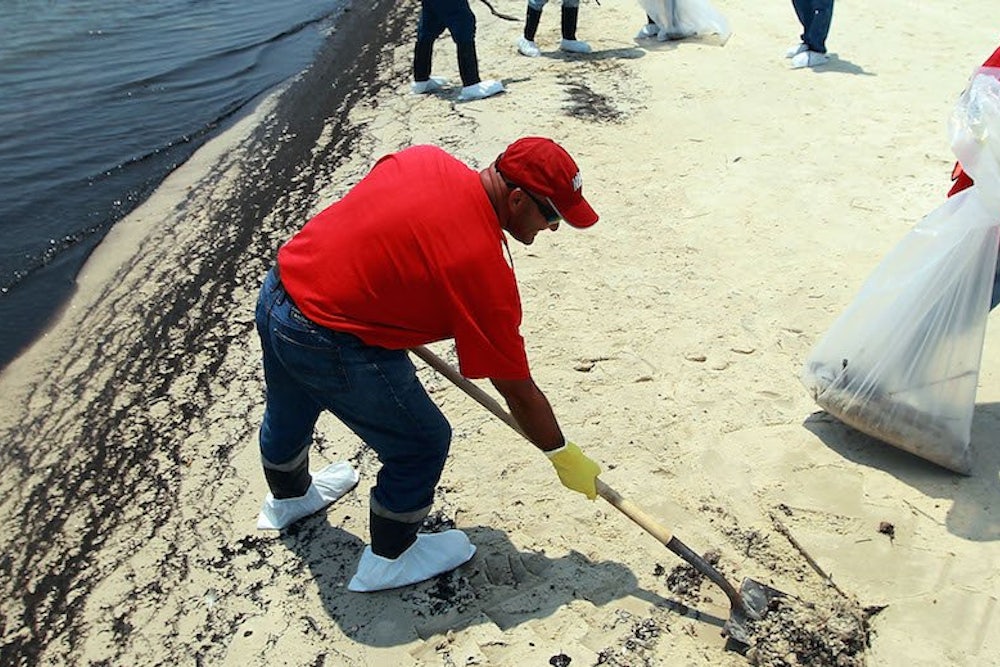Monday marks five years since BP’s Deepwater Horizon oil rig exploded, killing 11 workers and dumping 5 million barrels of oil into the Gulf of Mexico. Years later, dolphin, pelicans, turtles, and at least a dozen other species are still dying in record numbers, warned a report from the National Wildlife Federation last year.
BP’s accounting of the lasting impact from the disaster is much more pristine. "Data collected thus far shows that the environmental catastrophe that so many feared, perhaps understandably at the time, did not come to pass, and the Gulf is recovering faster than expected," BP's senior vice president and spokesman Geoff Morrell told news outlets, citing BP’s response as one reason for the rapid recovery (in reality, it took the company months just to contain the gushing oil).
The oil industry insists it has learned its lesson, and that “America’s oil and natural gas industry and our regulators have kept our commitment to make offshore operations safer than ever before,” Jack Gerard, president of the oil lobby American Petroleum Institute, said weeks ago.
But is offshore drilling much safer?
Both the oil industry and U.S. regulators point to data showing that accidents (meaning deaths, injuries, spills, and explosions) have dropped 14 percent from 2009 to 2014. But overall offshore drilling production was down almost 20 percent in 2014 compared to 2009. Since overall production decreased—due to a moratorium on deepwater drilling and companies shifting resources to fracking on land—accidents should have decreased, too.
But accidents per well have increased, according to Bob Deans, director of strategic engagement for the Natural Resources Defense Council. For each producing well, accidents were up 7 percent in 2014 compared to 2009. Since 2011, 11 offshore workers have died.
Deans, a co-author of a book examining the impact of the BP disaster, said these numbers show that “we can reduce the risk, but we can’t make [offshore drilling] safe.”
“The BP blowout was result of a long train of misjudgment and miscalculation,” Deans said. A combination of regulations and volunteer measures implemented since the accident has improved certain operations—like a recent rule requiring better maintenance of blow-out preventers. But regulators have tackled only a fraction of the problems exposed by the BP accident, such as poor oversight, maintenance, and well design.
For example, just last week, the Obama administration announces new rules targeting the blowout preventer, a piece of equipment attached to the oil well that's meant to guard against a spill, but which failed in BP's case. Yet the government never established an independent regulatory agency to ensure compliance with safety standards, leaving the industry to fill the oversight role instead. The API-run Center for Offshore Safety seems more focused on touting how safe offshore drilling already has become than on areas needing improvement.
Meanwhile, offshore drilling is poised to make a comeback. The Interior Department has proposed 10 leases in the Gulf of Mexico, three in the Arctic, and one in the Atlantic in the next few years.
The oil industry wants to stress how safe offshore drilling has become, even as it faces an unknown number of obstacles drilling in previously protected waters. The Arctic is particularly unfamiliar terrain, as a remote locations prone to unpredictable weather and ice that's more than 1,000 miles from the nearest Coast Guard station. Shell, which began exploring there in 2012, has already had some major mishaps and equipment failures. But the oil industry is painting a cheery narrative of the years since the Deepwater Horizon disaster to encourage the Obama administration to go even further in opening up the ocean for drilling.
